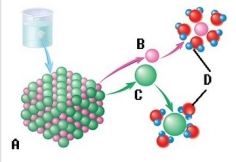A) mass
B) weight
C) atomic number
D) element
E) ionic charge
G) B) and C)
Correct Answer

verified
Correct Answer
verified
Multiple Choice
A weak acid was introduced to a solution. Which of the following accurately describes the condition of the solution after adding the weak acid?
A) The solution would have an increase in H+ with some of the weak acid molecules still intact.
B) The solution would have a decrease in H+ with some of the weak acid molecules still intact.
C) The solution would have an increase in H+ with none of the weak acid molecules still intact.
D) The solution would have a decrease in H+ with none of the weak acid molecules still intact.
F) C) and D)
Correct Answer

verified
Correct Answer
verified
Multiple Choice
Which of the following pairs is mismatched?
A) Synthesis reaction - two reactants combine to form a larger product
B) Decomposition reaction - large reactant broken into smaller products
C) Oxidation - gain of electrons
D) Dehydration reaction - water is a product of the reaction
E) Hydrolysis - water is used in decomposition reaction
G) A) and C)
Correct Answer

verified
Correct Answer
verified
Multiple Choice
A research group is monitoring a series of reactions and have determined it is most likely a hydrolysis reaction because the number of ________.
A) water molecules decreased
B) water molecules increased
C) oxygen molecules increased
D) oxygen molecules decreased
F) All of the above
Correct Answer

verified
Correct Answer
verified
Multiple Choice
When the hydrogen bonds that maintain a protein's three-dimensional shape are broken, the protein becomes nonfunctional, and is said to be ________.
A) essential
B) denatured
C) structural
D) unsaturated
E) saturated
G) A) and E)
Correct Answer

verified
Correct Answer
verified
Multiple Choice
Which of the following lists includes only monosaccharides that are isomers of one another?
A) Glycogen, glucose, sucrose
B) Starch, glycogen, cellulose
C) Glucose, fructose, galactose
D) Ribose, glycogen, glucose
E) Deoxyribose, glycogen, starch
G) A) and E)
Correct Answer

verified
Correct Answer
verified
Multiple Choice
Intermolecular forces
A) form dissociated ions.
B) are electrostatic attractions between different molecules.
C) evenly distribute electrical charge among all atoms in a sample.
D) separate atoms and ions from one another.
E) are found within molecules.
G) A) and B)
Correct Answer

verified
Correct Answer
verified
Multiple Choice
Which of the following is the correct complementary strand to CATGTC?
A) GTACAG
B) CATGTC
C) GUACAG
D) AGCACA
E) TCGTAT
G) D) and E)
Correct Answer

verified
Correct Answer
verified
Multiple Choice
Which of the following statements correctly describes ATP?
A) Can be synthesized from ADP
B) Stores and releases energy in the cell
C) Is associated with a reversible reaction
D) Is associated with anabolism and catabolism
E) All of the choices are correct.
G) B) and E)
Correct Answer

verified
Correct Answer
verified
Multiple Choice
Blood contains NaCl, protein, and cells. The NaCl is in a/an ________, the protein is in a/an ________, and the cells are in a ________.
A) emulsion; solution; suspension
B) solvent; emulsion; colloid
C) colloid; suspension; solution
D) suspension; colloid; solution
E) solution; colloid; suspension
G) A) and D)
Correct Answer

verified
Correct Answer
verified
Multiple Choice
The energy stored in ATP is a form of ________ energy.
A) mechanical
B) chemical
C) kinetic
D) heat
E) electrical
G) C) and E)
Correct Answer

verified
Correct Answer
verified
Multiple Choice
Most enzymes are ________.
A) cofactors
B) proteins
C) lipids
D) carbohydrates
E) nucleic acids
G) A) and E)
Correct Answer

verified
Correct Answer
verified
Multiple Choice
 -The sodium chloride molecule breaks apart in water. What does "C" represent?
-The sodium chloride molecule breaks apart in water. What does "C" represent?
A) Chloride ion
B) Dissociation
C) Water molecule
D) Sodium ion
E) Salt crystal
G) A) and E)
Correct Answer

verified
Correct Answer
verified
Multiple Choice
From the following list, select the one organic substance found in the human body.
A) Oxygen
B) Water
C) Glucose
D) Calcium
F) A) and C)
Correct Answer

verified
Correct Answer
verified
Multiple Choice
Chemical energy
A) moves matter.
B) results from the position or movement of objects.
C) is a form of potential energy within chemical bonds.
D) comes from the sun.
E) is not important in physiological processes.
G) D) and E)
Correct Answer

verified
Correct Answer
verified
Multiple Choice
Molecules that form when electrons are shared unequally between atoms are called ________ molecules.
A) salt
B) polar
C) nonpolar
D) lopsided
E) None of the choices are correct.
G) C) and D)
Correct Answer

verified
Correct Answer
verified
Multiple Choice
Considering the following analogy, determine which component represents ATP's role in the cells of the body. As the river flows past the old mill, it turns the water wheel, which in turns powers the movement of the millstone that grinds the wheat.
A) Water wheel
B) River
C) Millstone
D) Wheat
F) None of the above
Correct Answer

verified
Correct Answer
verified
Multiple Choice
 -The sodium chloride molecule breaks apart in water. What does "B" represent?
-The sodium chloride molecule breaks apart in water. What does "B" represent?
A) Chloride ion
B) Dissociation
C) Water molecule
D) Sodium ion
E) Salt crystal
G) B) and E)
Correct Answer

verified
Correct Answer
verified
Multiple Choice
Polysaccharides
A) are formed when sucrose and glucose combine.
B) are the smallest carbohydrates.
C) contain carbon, hydrogen, and phosphate atoms.
D) contain long chains of monosaccharides.
E) are not found in plants.
G) All of the above
Correct Answer

verified
Correct Answer
verified
Multiple Choice
A substance composed of two or more different types of atoms is a/an ________.
A) compound
B) element
C) ion
D) molecule
E) Both compound and molecule are correct.
G) B) and E)
Correct Answer

verified
Correct Answer
verified
Showing 181 - 200 of 207
Related Exams